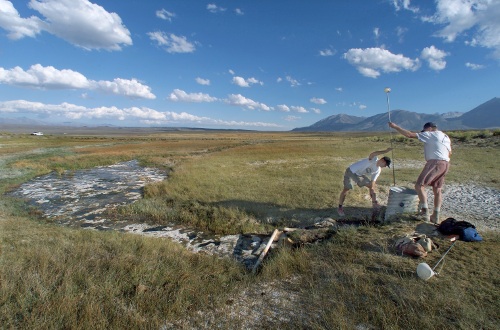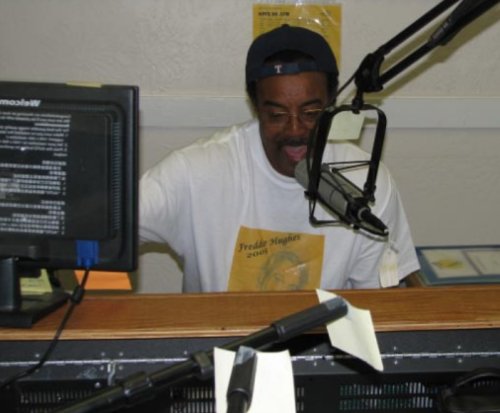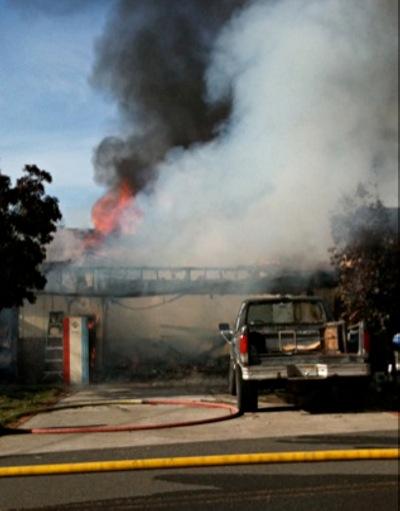- Elizabeth Larson
- Posted On
Rural California: Mining legislation has opponents, defenders
NORTHERN CALIFORNIA – In August, Gov. Arnold Schwarzenegger signed a bill to place an emergency moratorium on suction dredge mining.
The bill, SB 670, was authored by North Coast Sen. Patricia Wiggins, who said she was responding to concerns about salmon numbers.
The moratorium is to remain in place until the California Department of Fish and Game (DFG) completes and environmental impact review (EIR) on the practice. That process is under way, with scoping meetings taking place this month.
While supporters say it's a much-needed measure to protect fishing resources, opponents of the legislation have called it a smokescreen and a power grab by the Karuk Tribe.
Public Lands for the People is seeking to have an injunction placed on the moratorium, asserting that the state is interfering with federally protected mining rights.
Gerald Hobbs, president for Public Lands for the People, said the injunction should be in federal court next February.
“I think we'll prevail,” he said, adding that he wants to see suction dredge mining reinstated by next spring.
The measure has faced serious opposition since the beginning.
In a May statement made on the state Senate floor, Sen. Sam Aanestad, whose 12-county district in far Northern California saw a significant amount of suction dredge mining, called the legislation a “political end run,” by the Karuk, and urged fellow legislators to allow the DFG to continue with its review without interference.
Aanestad's office said there are more than 325 small retail businesses in the state involved in small scale gold dredging, and the ban would endanger their businesses.
He also pointed to $60 million in benefit that California's economy enjoys because of the spending of small scale gold dredgers as they purchase fuel, food, camping, diving equipment, hardware and lodging purchases.
The measure passed anyway.
“The proposed ban poses yet another significant blow to the fragile rural economies that I represent,” Aanestad wrote to Schwarzenegger in an attempt to get the governor to veto the bill.
Aanestad pointed out in his letter to the governor that there is no scientific evidence on record that shows suction dredge mining is harmful to the environment. He quoted a study by the U.S. Army Corps of Engineers concluded that “the effects of suction dredge mining are so small and so short-term as to not warrant the regulations being imposed in many cases.”
Businessman Bruce Johnson, who owns the 20-space Mid River RV Park in the Seiad Valley, 20 miles east of Happy Camp, estimated that 97 percent of his business is in jeopardy because of the ban.
Johnson, himself a suction dredge miner, said fellow miners have kept his park busy during the critical months of April to October. In turn, they've supported other businesses in the area.
Without their business, he's looking at the loss of his livelihood and an estimated two-thirds reduction in his park's value.
The miners contribute more than $2,500 to the Seiad Valley Volunteer Fire Department, where Johnson is a board member. Without those fund, he expects the fire department could close, which will have a ripple effect likely to impact local homeowners, who will not have that important safety net and can expect to pay higher fire insurance.
Johnson said he's already lost employees. If his park goes out of business, Johnson said other businesses may follow.
Just down the road is the Seiad Cafe, internationally renowned thanks to its pancake challenge. It, too, could go away.
“These are things that, once they're gone, you can't get back,” Johnson said.
Fishing numbers down
The Karuk Tribe's campaign coordinator, S. Craig Tucker, PhD, said even in a good year for fish runs on the Klamath, fish numbers still are only about 8 to 10 percent of historical abundance.
In recent years, commercial fishing guides are out of work and tribal members are unable to provide salmon for families or for ceremonies.
“We do have some evidence that it causes an impact,” he said of dredging.
Some studies show that it reintroduces the highly toxic methylmercury into the water column.
The Pacific Fisheries Management Council, which advises the federal government on how many fish can be harvested, includes in its harvest allocation enough fish to divide between natives and non-natives, he said.
He said tribal members are still fishing and harvesting the allocation.
Tucker said the tribes have a right to a subsistence fishery. Thee Karuk Tribe has the most limited fishery among the tribes in the lower Klamath. Recently, the Karuk caught a couple hundred fish for 4,000 tribal members.
He said there are more fishermen who generate more economic activity than miners and suction dredge mining.
There are many reasons for habitat problems, said Tucker. Mining is just one of them; timber harvesting and dams are among many others.
The miners have never been limited in their activity, said Tucker. “Fishermen can't go fishing, but the restrictions haven't applied to the miners,” he said.
Tensions arise between miners, tribe
Much of the tension regarding suction dredge mining has arisen through disagreements between miners and the Karuk Tribe, assisted by what Johnson called “eco nuts.”
Siskiyou County Supervisor Marcia Armstrong said the New 49ers, one of the principal mining groups in Northern California, purchased a lot of mining claims on the lower Klamath River and upper Salmon River, where not much mining had taken place.
Lawsuits began several years ago, said James Buchal, a Portland, Ore. attorney who represents the New 49ers.
He became involved about five years ago. At that point, the New 49ers had sat down with the tribe to work out which areas were culturally sensitives and should be avoided by the miners. The group then got the DFG permits, and the tribe promptly sued, he said.
Tucker said the tribe met with various mining groups but “No one could exactly represent the entire mining community.”
He said the Karuk offered the miners a settlement in 2006 which included restrictions on mining in the Klamath, particularly around critical habitat areas at certain times.
“It was a pretty modest restriction,” he said. “The state of California was willing to accept it, the miners were not.”
In particular, the New 49ers blocked the agreement, and everyone else got punished for it, said Tucker.
He added, “I don't think compromise is in their vocabulary,” which he said led to the statewide ban.
Outside of court, miner alleges that there were altercations between them and tribal members. The sabotage included damaging cars and worse; Johnson said someone wiped down equipment with poison oak, and a woman ended up in the hospital.
Worse still, shots were fired over club members' heads. “There's no way to legitimize this behavior,” he said.
Tucker said he's unaware of tribal members trying to intimidate miners. However, he said he can show reams of comments from Internet chat forums in which miners made racist and threatening comments toward the tribe.
He said showing up in the middle of an Indian community with a name like “New 49ers” shows a lack of cultural sensitivity.
Buchal said he has study after study that show fish aren't harmed, and no sign that the practice has ever killed fish.
He cited a study by now-retired Oregon State University professor, Peter Bayley, who studied the Rogue River and found no relationship between mining and fishing numbers.
Buchal blames a mix of politics by environmental groups, lobbyists, the tribe and the Legislature – which he called “essentially insane” – for the ban.
“The fishermen, to some extent, have wiped out the fish through overfishing,” he said.
That, coupled with terrible ocean conditions in the 1990s, led to the fishing situation and the subsequent mining ban, said Buchal.
“The chief fallout,” noted Buchal, “is that people just go to other states to mine.”
The possibility of an influx of miners has Oregon Gov. Ted Kulongoski concerned. On Oct. 15 he wrote to Secretary of the Interior Ken Salazar to ask for wilderness protection for the Siskiyou Wild Rivers area surrounding the existing Kalmiopsis Wilderness.
“California recently banned the use of suction dredge mining, the same type of destructive mining that is used in southwest Oregon,” he wrote. “We are very concerned that the suction dredge miners are now
heading for Oregon.”
Johnson said he believes people who have decided that natural resources are good nothing more than taking pictures are now in control, and he believes that attitude ties in with the efforts to remove dams on the rivers.
“The voices of people on this side of the issue are not being heard,” he said. “I don't know where to go from here.”
Different perspectives on mining's impacts
Armstrong said that suction dredge mining – which can't take place during salmon spawning or during the summer steelhead run – isn't responsible for fish declines. She said 80 to 90 percent of the juvenile salmon are lost to disease in the Klamath River, not its tributaries.
Total maximum daily load (TMDL) restrictions also have been proposed for the practice, Armstrong said.
She said the bottom of the creeks have, in some areas, become like hardpan from earlier mining practices. The suction dredging has been shown to create deep water holes for the fish, and are helping open up old, sealed springs that had contributed to water temperatures.
Johnson, who has worked as a commercial fisherman in Alaska and loves being around fish, said suction dredge mining neither kills nor hurts them.
He explained that they vacuum materials up off the bottom of the creek, put them through a filter and put the rest of the materials back into the creek. Usually, fish come near to feed off the biomass that's being released from the process, which he said is “really cool” to see.
“It's an amazing little ecosystem that starts going on there,” he said.
Dr. Peter Moyle, professor of wildlife, fish and conservation biology at the University of California, Davis' Center for Watershed Sciences, has conducted studies on the practice and concluded that it has a negative impact.
“It is too soon to tell if the moratorium has has a positive impact on salmon populations and in fact this will always be hard to demonstrate because no one is studying the issue,” Moyle told Lake County News in an e-mail message.
Moyle said the state's fisheries agencies, such as DFG, are “woefully short” of funds and manpower to do their jobs. “Also there are multiple factors affecting the fish populations so separating causes is difficult,” he wrote.
“But given the severely threatened nature of summer steelhead, spring chinook salmon, and coho salmon populations it is best to assume that dredging (and associated activity) is having a negative impact unless it can be proven otherwise. As studies show, there are lots of reasons to suspect an impact is there,” Moyle noted.
He said the salmon involved in the Klamath are the same as those on the North Coast, although somewhat different populations, including steelhead, coho and chinook.
Tucker said the moratorium “seems to be mostly working.”
Armstrong said they're expecting one of the best chinook runs in many years this year, despite the fact that earlier in the season dredging was not taking place.
Tucker agreed, attributing the better run to the fact that there is virtually no ocean commercial fishing season. When there is no fishing pressure in the ocean there will be more fish in the Klamath. Meanwhile, he said there was a “horrible” run of fish on the Sacramento River.
Dwindling chances to build wealth
Hobbs said opponents are treating suction dredge mining like a recreational activity, when it's a wealth building activity that he maintains is protected by the US Constitution's Fifth and 14th Amendments.
“If it doesn't come from the earth it doesn't create wealth,” he said.
For those who suction dredge mine, Hobbs explained that a bad season means they can't carry themselves through the winter.
Hobbs said science “is nonexistent today,” and accused Moyle and other scientists of twisting the evidence to suit the environmentalists' agenda.
He added that the fight over suction dredge mining is all about money, because small small miners are the last wealth building entities that exist.
Tucker said everyone is going to have to make some sacrifices – including miners – if fisheries are to be restored.
While there are about 4,000 suction dredge permits, there are 2.4 million fishing license, not counting those for commercial fishing, he said.
“Fish,” Tucker added, “are more valuable than gold.”
Current information on the DFG review and its schedule is available at www.dfg.ca.gov/suctiondredge/ . Additional information can be found at www.dfg.ca.gov/licensing/specialpermits/suctiondredge .
E-mail Elizabeth Larson at This email address is being protected from spambots. You need JavaScript enabled to view it. . Follow Lake County News on Twitter at http://twitter.com/LakeCoNews and on Facebook at http://www.facebook.com/pages/Lake-County-News/143156775604?ref=mf .

 How to resolve AdBlock issue?
How to resolve AdBlock issue? 










